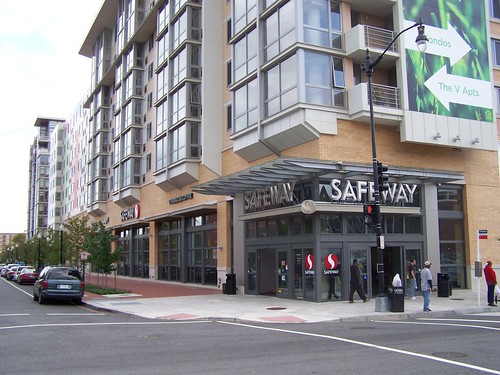City Target to open in Seattle

Above: City Target in Seattle. Photo by David Nelson. Interesting that the block is horizontal mixed use, but that the Target building is single use. The Rise project in Vancouver BC has housing above. So does the CityVista project in DC, with apartments or condominiums above retail, including a Safeway. Below: CityVista, DC.

Cities are still dealing with the impact of major big box retail chains wanting to open stores in center cities, after the companies have focused decades on expanding in the suburbs.
The issue comes down to how the stores are integrated into the urban fabric.
Even though the companies want to be in the center city, it is a struggle to get them to modify their design and operating practices to work in a more nuanced fashion that is appropriate for the city.
The issues come down to:
- size
- more traditional suburban format (with some tweaks) either standalone or as part of a strip type shopping center
- versus integration into a mixed use project
- how much parking is provided
- how much support for sustainable transportation is provided
- coordinated customer delivery and management of freight delivery
- locating the store(s) in locations that are well served by transit, preferably fixed rail
Most cities appear to lack more fine-grained requirements with regard to large retailers, to more strongly shape and "encourage" them to make more appropriate urban design decisions.
So DC/USA, the big Target-anchored shopping center in DC's Columbia Heights neighborhood (also anchored by a Best Buy and Bed Bath and Beyond) is about 170,000 square feet, and the shopping center has 1,000 parking spaces (at least half go unused since the center is located on top of a subway station and is on a highly used busline).

DC/USA, 14th Street NW, Columbia Heights, Washington, DC.
The new City Target in Seattle is 96,000 square feet over three floors and has 185 parking spaces. Still, only parking for 22 bicycles, and using sub-standard racks (wave racks) at that. It is located on a key bus line corridor, with service from more than one dozen different bus routes. Unlike other Target stores, they will be playing music and displaying clothing on mannequins (what a level of innovation!). They'll have a reduced array of goods (e.g., fewer sizes of the same product) and slightly higher prices. From "Urban-friendly Target to open this week in downtown Seattle" from the Seattle Times:
While the breadth of City merchandise is similar to what you'd see at other Targets, there are some differences.
"Instead of three sizes of Windex bottles, you may just see one," said Target spokeswoman Molly Snyder, conducting a guided tour of the store last week.
Flat-screen TVs measure 60 inches or less, down from a maximum of 70 inches in a typical Target. Paper-towel rolls come in packs of eight or 12.
"People who live downtown typically don't have room to store 24 rolls of paper towels," Snyder said.
The store also has a section called "CityLove," with Seattle souvenirs, including T-shirts, coffee mugs and postcards. For non-English-speaking customers, navigational signs show a different icon for each department, such as a ring for jewelry, or light bulb for home improvement.
Unlike regular Targets, City plays background music and uses window mannequins to showcase apparel. A touch of whimsy brightens the women's dressing rooms, where hooks are labeled "for sure" and "not so much."
Prices likely will be another difference. Retail experts say City prices could run 10 percent higher than at regular Targets to make up for the increased costs of doing business downtown. It's a claim Target officials do not deny.
"I think guests understand that in urban markets, there's a higher cost of doing business. So our prices will vary," Snyder said. "Some will be consistent with other Targets, and some may be slightly higher."
It's located downtown, and by Pike Place Market, the city's public market which is a major destination in the city (both Sur la Table and Starbucks started in the Pike Place Market District). This is interesting because in the development of cities, department store districts tended to develop around public marketplaces, so this is a kind of way of history repeating.

This rendering of the City Target going into Downtown Portland shows that the 89,000 s.f. store will locate in a historic building, a building that might have even been a department store in a past life. See "Portland, Target unveil plans for City Target at the Galleria downtown" from the Portland Oregonian.
Labels: big box retail ordinances, commercial district revitalization planning, formula retail, mixed use development, urban design/placemaking, urban revitalization



0 Comments:
Post a Comment
<< Home